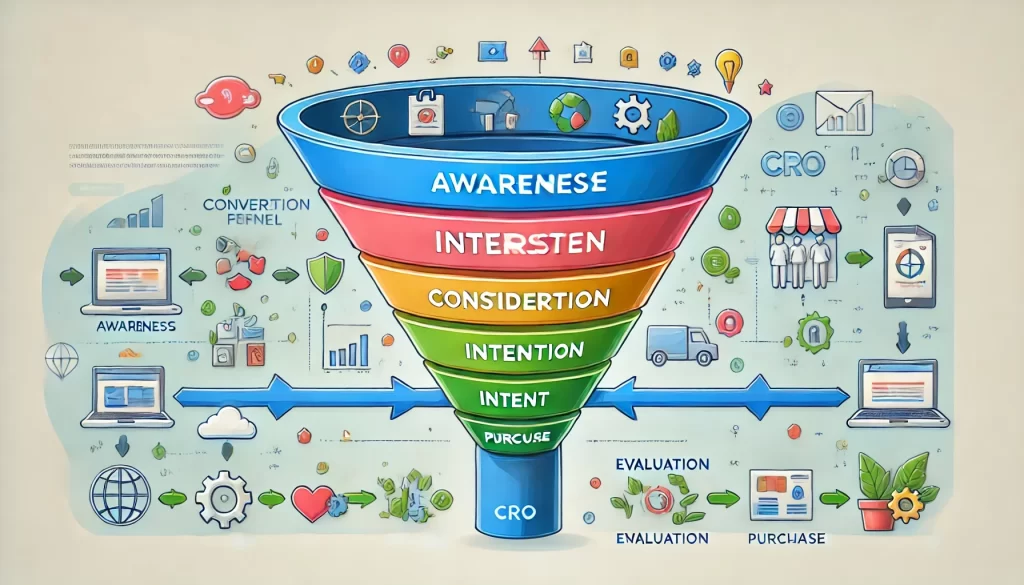
Introduction
You’ve just finished developing a beautiful website, but what’s next? In today’s digital environment, attracting visitors to your site is only the beginning. The real challenge is converting those visitors into loyal customers, subscribers, or leads. This is where conversion optimization becomes crucial. Even a slight improvement in your conversion rate can significantly boost your revenue.
Understanding and implementing effective conversion optimization strategies can enhance user experiences, increase engagement, and ultimately drive more actions that benefit your business. This article delves into the world of conversion optimization, explaining why it’s an indispensable part of your digital strategy and how it can transform your business outcomes.
1. Understanding Conversion Optimization
Conversion optimization, also known as conversion rate optimization (CRO), is the systematic process of increasing the percentage of website visitors who take a desired action—whether that action is making a purchase, filling out a form, or subscribing to a newsletter. Unlike general search engine optimization (SEO), which focuses on driving traffic to your site, conversion optimization is about maximizing the value of the traffic you already have.

At its core, conversion optimization involves understanding how users navigate your site, what actions they take, and what’s stopping them from completing your goals. It’s a blend of art and science, requiring both creative design elements and data-driven decisions based on your analytical and customer survey data. The primary goals of conversion optimization can vary based on the nature of your business. For e-commerce sites, the goal is often to increase sales. For a service-based business, it might be generating more leads. For content websites, it could be driving more subscriptions or downloads. Regardless of the specific goal, the aim is to enhance the user experience in a way that encourages desired actions or outcome.
Metrics: To effectively optimize conversions, it’s crucial to monitor key performance indicators (KPIs) that reflect your progress. The most important metrics include:
- Conversion Rate: The percentage of visitors who complete the desired action. This is the most direct measure of your conversion efforts.
- Bounce Rate: The percentage of visitors who leave your site after viewing only one page. A high bounce rate can indicate that visitors aren’t finding what they’re looking for.
- Average Session Duration: The average amount of time visitors spend on your site. Longer sessions typically suggest higher engagement.
2. The Importance of Conversion Optimization
Conversion optimization is more than just a fancy word often used by marketers today; it’s a critical aspect of any successful online strategy and here’s why:

Business Impact: Improving conversion rates directly affects your bottom line. By increasing the percentage of visitors who take desired actions, you can significantly boost your revenue without needing to increase traffic. This makes your existing marketing efforts more effective and delivers a higher return on investment.
Customer Experience: Conversion optimization focuses on understanding and enhancing the user journey. By making your website easier to navigate, more engaging, and more aligned with user needs, you create a better overall experience. Satisfied visitors are more likely to convert, return, and recommend your site to others, fostering long-term loyalty and word-of-mouth referrals.
Competitive Edge: In today’s competitive market, businesses that prioritize conversion optimization stand out. A website that’s finely tuned to meet user needs will outperform competitors, attract more leads, and convert them more effectively. This competitive advantage can be a decisive factor in your business’s success.
Conversion optimization isn’t just about immediate gains; it’s about building a sustainable, user-centered approach that continues to drive growth and engagement over time.
3. Key Elements of Conversion Optimization
Effective conversion optimization involves a combination of several key elements, each contributing to the overall goal of turning visitors into customers.

User Experience (UX): A positive user experience is the foundation of conversion optimization. This includes intuitive site navigation, mobile responsiveness, and fast page load times. Users should be able to find what they’re looking for quickly and easily, without frustration. Investing in UX design can lead to significant improvements in conversion rates.
Content Quality: High-quality, relevant content is crucial for engaging visitors and guiding them towards conversion. Content should be clear, compelling, and aligned with user intent. This includes everything from product descriptions and blog posts to images and videos. Engaging content keeps users on your site longer and encourages them to take action.
Call-to-Action (CTA): CTAs are a critical component of conversion optimization. They guide users towards the next step, whether it’s making a purchase, signing up for a newsletter, or contacting your team. Effective CTAs are clear, compelling, and strategically placed. For example, a strong CTA might read, “Get Your Free Trial Today” or “Sign Up Now and Save 20%.”
A/B Testing: A/B testing is a method used to compare two versions of a webpage or element to determine which performs better. By testing different headlines, images, CTAs, and layouts, you can identify what resonates most with your audience. This data-driven approach helps refine your site’s design and content for optimal performance.
Landing Pages: Optimized landing pages are essential for driving conversions. These are the pages users land on after clicking an ad or link, and they should be tailored to match the intent of that specific audience. Effective landing pages are focused, relevant, and include strong CTAs. They should eliminate distractions and guide the user smoothly towards conversion.
Effective conversion optimization requires continuous analysis, testing, and refinement to ensure each element works harmoniously to enhance overall performance.
4. Strategies for Effective Conversion Optimization
To implement a successful conversion optimization strategy, consider the following approaches:
Data Analysis: Analyzing user data is crucial for understanding behavior and identifying areas for improvement. Use tools like Google Analytics to track user interactions, conversion rates, and other key metrics. Data analysis helps pinpoint bottlenecks and areas where users drop off, allowing you to make informed decisions about where to focus your optimization efforts.
Personalization: Personalizing content and experiences can significantly boost conversion rates. Tailor your website’s content based on user behavior, preferences, and demographics. Personalized recommendations, dynamic content, and targeted offers create a more engaging and relevant user experience, increasing the likelihood of conversion.

Social Proof: Leveraging social proof, such as reviews, testimonials, and case studies, can build trust and credibility with potential customers. Displaying positive feedback from satisfied customers can reassure new visitors and encourage them to take action. Highlighting social proof prominently on your website can have a powerful impact on conversion rates.
Simplifying Processes: Reducing friction in the user journey is essential for improving conversions. Simplify forms, streamline the checkout process, and minimize the steps required to complete a desired action. The easier and more intuitive the process, the more likely users are to follow through and convert.
Trust Signals: Trust signals, such as security badges, clear privacy policies, and money-back guarantees, can alleviate concerns and build confidence in your website. Ensuring that users feel secure and confident while interacting with your site can significantly increase conversion rates.
5. Common Pitfalls and How to Avoid Them
While conversion optimization can significantly enhance your website’s performance, there are common pitfalls that can hinder your efforts. Being aware of these mistakes and knowing how to avoid them is crucial for success.
Ignoring Data: One of the biggest mistakes is making changes based on assumptions rather than data. Decisions should be driven by analytics and user feedback to ensure they are addressing real issues and opportunities. Regularly review your website’s performance metrics and user behavior data to inform your optimization strategies.
Overcomplicating the User Experience: While it’s important to provide valuable content and features, an overly complex design can overwhelm users and lead to higher bounce rates. Keep your website clean, intuitive, and easy to navigate. Focus on simplicity and clarity, ensuring that users can quickly find the information they need and complete desired actions without confusion.

Neglecting Mobile Users: With an increasing number of users accessing websites via mobile devices, neglecting mobile optimization can severely impact your conversion rates. Ensure your website is fully responsive and provides a seamless experience across all devices. Mobile-friendly design, fast load times, and easy navigation are essential for capturing and converting mobile users.
Failing to Test: Without A/B testing, you’re essentially guessing which changes will improve conversions. Regularly test different versions of your webpages, CTAs, and other elements to determine what works best. Continuous testing and iteration are key to optimizing your website’s performance over time.
Ignoring User Feedback: Users can provide valuable insights into what’s working and what’s not. Ignoring their feedback can lead to missed opportunities for improvement. Use surveys, feedback forms, and user testing sessions to gather input and identify areas for enhancement.
Recognizing these common pitfalls and proactively addressing them ensures that your conversion optimization efforts are effective and yield the best possible results.
Conclusion
Conversion optimization is an essential component of any successful digital strategy. It goes beyond merely attracting visitors to your site; it focuses on turning those visitors into loyal customers, subscribers, or leads. Understanding the key elements of conversion optimization, implementing effective strategies, and avoiding common pitfalls can significantly enhance your website’s performance and achieve better business outcomes.
Understanding the key elements of conversion optimization, implementing effective strategies, and avoiding common pitfalls can significantly enhance your website’s performance and achieve better business outcomes. It’s crucial to have a reliable web partner to guide you through this process. Consider partnering with us; we have the experience and an extensive portfolio to back our expertise.
